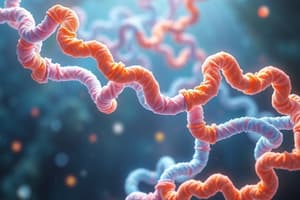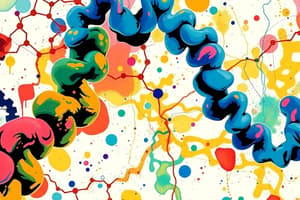Podcast
Questions and Answers
Which statement accurately describes the configuration of amino acids in proteins?
Which statement accurately describes the configuration of amino acids in proteins?
- Glycine is the only amino acid that is chiral.
- Stereoisomers cannot exist in amino acids.
- L-configuration is found in all amino acids in proteins. (correct)
- All amino acids in proteins are in D-configuration.
At what pH does an amino acid mostly exist as a zwitterion?
At what pH does an amino acid mostly exist as a zwitterion?
- At the isoelectric point. (correct)
- At a pH above the isoelectric point.
- At a pH below its isoelectric point.
- Zwitterions never occur at any specific pH.
Which of the following amino acids is classified as essential?
Which of the following amino acids is classified as essential?
- Histidine
- Glutamine
- Threonine (correct)
- Arginine
What characterizes the primary structure of a protein?
What characterizes the primary structure of a protein?
Which type of bond primarily stabilizes the secondary structure of proteins?
Which type of bond primarily stabilizes the secondary structure of proteins?
Which amino acid is characterized by having an achiral carbon?
Which amino acid is characterized by having an achiral carbon?
Which of the following amino acids is involved in the transfer of methyl groups?
Which of the following amino acids is involved in the transfer of methyl groups?
Which amino acid is associated with the condition known as Maple Syrup Urine Disease (MSUD)?
Which amino acid is associated with the condition known as Maple Syrup Urine Disease (MSUD)?
What is the main function of Cysteine in proteins?
What is the main function of Cysteine in proteins?
Which amino acid is a precursor for Serotonin and Melatonin?
Which amino acid is a precursor for Serotonin and Melatonin?
Which of the following amino acids is positively charged at physiological pH?
Which of the following amino acids is positively charged at physiological pH?
What type of group characterizes aromatic amino acids?
What type of group characterizes aromatic amino acids?
Which amino acid is primarily linked to O-linked glycosylation in the Golgi apparatus?
Which amino acid is primarily linked to O-linked glycosylation in the Golgi apparatus?
What is the role of Glutamine in the body?
What is the role of Glutamine in the body?
Which amino acid is known for contributing to the fibrous structure of collagen?
Which amino acid is known for contributing to the fibrous structure of collagen?
What represents the unique aspect of each amino acid in its fundamental structure?
What represents the unique aspect of each amino acid in its fundamental structure?
Which of the following is NOT a type of amino acid based on the nature of its side chain?
Which of the following is NOT a type of amino acid based on the nature of its side chain?
What is the primary function of enzymes in living organisms?
What is the primary function of enzymes in living organisms?
What is the term for the set of all proteins expressed by a cell at a specific time?
What is the term for the set of all proteins expressed by a cell at a specific time?
Which of the following statements best describes the relationship between isoelectric pH and amino acids?
Which of the following statements best describes the relationship between isoelectric pH and amino acids?
What role do contractile proteins play in muscular systems?
What role do contractile proteins play in muscular systems?
Which bond in a peptide backbone is free to rotate, affecting conformation?
Which bond in a peptide backbone is free to rotate, affecting conformation?
Why is the study of proteomics significant in understanding cellular functions?
Why is the study of proteomics significant in understanding cellular functions?
What is the general shape of an alpha helix?
What is the general shape of an alpha helix?
Which of the following amino acids is known to disrupt the formation of an alpha helix?
Which of the following amino acids is known to disrupt the formation of an alpha helix?
What type of bonding predominantly stabilizes tertiary structures of proteins?
What type of bonding predominantly stabilizes tertiary structures of proteins?
What is the key difference between alpha helices and beta sheets in terms of hydrogen bond direction?
What is the key difference between alpha helices and beta sheets in terms of hydrogen bond direction?
Which type of secondary structure appears as a flat, pleated sheet?
Which type of secondary structure appears as a flat, pleated sheet?
What role do domains play in protein structure?
What role do domains play in protein structure?
What causes denaturation in proteins?
What causes denaturation in proteins?
What type of structure is formed by proteins consisting of more than one polypeptide chain?
What type of structure is formed by proteins consisting of more than one polypeptide chain?
Flashcards are hidden until you start studying
Study Notes
Amino Acids
- There are over 300 amino acids but only 20 are commonly found in mammalian proteins
- All amino acids have the same fundamental structure: a central carbon atom, an amino group (NH2), a carboxyl group (COOH) and a hydrogen atom
- The R group or side chain differentiates amino acids
- Amino acids can be classified into 6 categories: aliphatic side chains, OH groups, SH groups, basic groups, acidic groups, aromatic side chains
Aliphatic Side Chains
- Glycine (Gly, G) is the only amino acid with an achiral carbon due to its hydrogen side chain
- Glycine is used in heme synthesis, purine synthesis, and is a major inhibitory neurotransmitter in the SPINAL CORD
- Alanine (Ala, A) carries nitrogen from peripheral tissues to the liver
- Valine (Val, V), Isoleucine (Ile, I), and Leucine (Leu, L) are branched-chain amino acids whose metabolites accumulate in MSUD (Maple Syrup Urine Disease)
OH Groups
- Serine (Ser, S) is a phosphorylation site for enzyme modification
- Threonine (Thr, T) is linked to carbohydrate groups in glycoproteins
- Tyrosine (Tyr, Y) is a precursor of thyroxine and melanin
SH Groups
- Cysteine (Cys, C) contains a sulfhydryl group that is an active part of many enzymes
- Two cysteines can be connected by a covalent Disulfide bond to form Cystine
- Methionine (Met, M) transfers methyl groups as SAM
Basic Groups
- Histidine (His, H) is a precursor of histamine and is used in the diagnosis of Folic Acid Deficiency
- Arginine (Arg, R) is a precursor of Urea, Creatinine and Nitric Oxide
- Lysine (Lys, K) is involved in the production of collagen and elastin
Acidic Groups
- Aspartic acid (Asp, D) and Glutamic acid (Glu, E) are proton donors
- Asparagine (Asn, N) and Glutamine (Gln, Q) are involved in amino acid metabolism
Aromatic Groups
- Tryptophan (Trp, W) has the largest aromatic side chain
- Phenylalanine (Phe, F) accumulates in phenylketonuria
Imino Groups
- Proline (Pro, P) is a non-standard amino acid because its side chain is linked to the nitrogen group of the amino group
- Proline's structure contributes to the fibrous structure of collagen and interrupts α-helices in globular proteins
Nonpolar Side Chains
- Nonpolar side chains have a net charge of zero at physiologic pH
- They are not acidic or basic and do not bind or give off protons
- Nonpolar side chains promote hydrophobic interactions and cluster in the interior of proteins
Uncharged, Polar Side Chains
- Uncharged, polar side chains have a net charge of zero at physiologic pH
- They can form hydrogen bonds
- They are often found on the surface of proteins where they can interact with water molecules
Acidic Side Chains
- Acidic side chains are negatively charged at physiologic pH because of the carboxylate group
- They are proton donors and participate in ionic reactions
- Glutamate (Glu, E) is the precursor of GABA and Glutathione
Basic Side Chains
- Basic side chains are positively charged at physiologic pH because of the amine group
- They are proton acceptors and participate in ionic reactions
Selenocysteine, the 21st Amino Acid
- Selenocysteine is an L-α amino acid found in proteins such as peroxidases, reductases, selenoprotein P, and iodothyronine deiodinases
Optical Properties of Amino Acids
- All amino acids except Glycine are chiral
- L-configuration is found in proteins
- D-configuration is found in bacterial walls and antibiotics
- Stereoisomers/Isomers/Enantiomers are exact mirror images of each other
Charge of Amino Acids
- Amino acids can have a positive, negative, or zero charge depending on the pKa values and pH of the environment
- Zwitterion Molecule is a chemical compound with a total net charge of zero
- Isoelectric pH or Isoelectric Point is the pH where the zwitterion predominates
Essential Amino Acids
- Essential amino acids cannot be synthesized by the body and must be obtained from the diet
- Essential amino acids include: Phenylalanine, Valine, Tryptophan, Threonine, Isoleucine, Methionine, Histidine, Arginine, Leucine, Lysine
Conditionally Essential Amino Acids
- Conditionally essential amino acids are not typically required but can become necessary under certain conditions
- Conditionally essential amino acids include: Arginine and Histidine
Protein Structures
- Proteins have four levels of structure: primary, secondary, tertiary, and quaternary
Primary Structure
- Primary structure refers to the linear sequence of amino acids in a polypeptide chain
- Peptide bonds connect the α-amino group of one amino acid to the α-carbonyl group of another
- Peptide bonds are very stable and can only be disrupted by hydrolysis or prolonged exposure to a strong acid/base at elevated temperatures
Secondary Structure
- Secondary structure refers to the local folding of the polypeptide chain into three-dimensional structures
- Two main types of secondary structure are α-helix and β-pleated sheets
- Secondary structure is stabilized by hydrogen bonding
Alpha-Helix
- The α-helix is a right-handed spiral structure with the polypeptide backbone core side chains extending outward
- The α-helix is stabilized by hydrogen bonds between the carbonyl and amino groups of the polypeptide backbone
- Proline, large R groups, and charged R groups disrupt the α-helix
Beta-Pleated Sheet
- The β-pleated sheet is formed by two or more polypeptide chains that are parallel to each other
- The β-pleated sheet is stabilized by hydrogen bonds between the carbonyl and amino groups of the polypeptide backbone
- The β-pleated sheet can be either parallel or antiparallel
Tertiary Structure
- Tertiary structure refers to the overall three-dimensional shape of a protein
- It refers to the folding of domains and their final arrangement in the polypeptide
- Tertiary structure is stabilized by disulfide bonds, hydrophobic interactions, and hydrogen bonds
- Examples of tertiary structures include globular proteins and fibrous proteins
Domains
- Domains are fundamental functional and three-dimensional structural units of a polypeptide
- Domains are formed by a combination of motifs
Quaternary Structure
- Quaternary structure refers to the arrangement of multiple polypeptide chains (subunits) in a protein complex
- Quaternary structure is stabilized by noncovalent bonds
Denaturation
- Denaturation is the disruption of a protein’s structure
- When a protein becomes unfolded and disorganized, they become dysfunctional
- Denaturation can be reversible
- Causes of denaturation include heat, organic solvents, mechanical mixing, and heavy metal ions
Prion Diseases
- Prion diseases are caused by the misfolding of a protein called the prion protein
- Misfolded prion proteins can convert other normal prion proteins into misfolded forms
- Misfolded prion proteins aggregate and form amyloid plaques, which can damage brain tissue
Alzheimer's Disease
- Alzheimer's disease is caused by the accumulation of amyloid-beta plaques and neurofibrillary tangles in the brain
- Amyloid-beta plaques are formed by misfolded amyloid-beta proteins
- Neurofibrillary tangles are formed by misfolded tau proteins
- Both amyloid-beta plaques and neurofibrillary tangles contribute to the death of brain cells and the symptoms of Alzheimer's disease
Studying That Suits You
Use AI to generate personalized quizzes and flashcards to suit your learning preferences.




